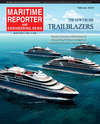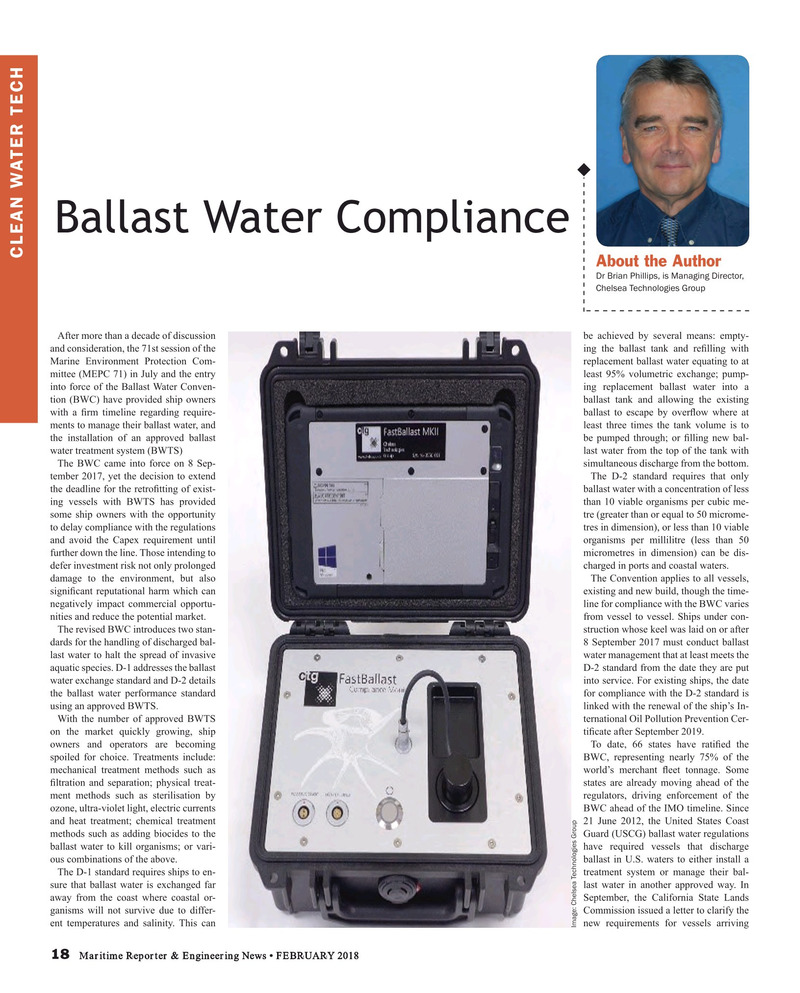
Page 18: of Maritime Reporter Magazine (February 2018)
Cruise Ship Annual
Read this page in Pdf, Flash or Html5 edition of February 2018 Maritime Reporter Magazine
Ballast Water Compliance
CLEAN WATER TECH
About the Author
Dr Brian Phillips, is Managing Director,
Chelsea Technologies Group
After more than a decade of discussion be achieved by several means: empty- and consideration, the 71st session of the ing the ballast tank and re? lling with
Marine Environment Protection Com- replacement ballast water equating to at mittee (MEPC 71) in July and the entry least 95% volumetric exchange; pump- into force of the Ballast Water Conven- ing replacement ballast water into a tion (BWC) have provided ship owners ballast tank and allowing the existing with a ? rm timeline regarding require- ballast to escape by over? ow where at ments to manage their ballast water, and least three times the tank volume is to the installation of an approved ballast be pumped through; or ? lling new bal- water treatment system (BWTS) last water from the top of the tank with
The BWC came into force on 8 Sep- simultaneous discharge from the bottom. tember 2017, yet the decision to extend The D-2 standard requires that only the deadline for the retro? tting of exist- ballast water with a concentration of less ing vessels with BWTS has provided than 10 viable organisms per cubic me- some ship owners with the opportunity tre (greater than or equal to 50 microme- to delay compliance with the regulations tres in dimension), or less than 10 viable and avoid the Capex requirement until organisms per millilitre (less than 50 further down the line. Those intending to micrometres in dimension) can be dis- defer investment risk not only prolonged charged in ports and coastal waters. damage to the environment, but also The Convention applies to all vessels, signi? cant reputational harm which can existing and new build, though the time- negatively impact commercial opportu- line for compliance with the BWC varies nities and reduce the potential market. from vessel to vessel. Ships under con-
The revised BWC introduces two stan- struction whose keel was laid on or after dards for the handling of discharged bal- 8 September 2017 must conduct ballast last water to halt the spread of invasive water management that at least meets the aquatic species. D-1 addresses the ballast D-2 standard from the date they are put water exchange standard and D-2 details into service. For existing ships, the date the ballast water performance standard for compliance with the D-2 standard is using an approved BWTS. linked with the renewal of the ship’s In-
With the number of approved BWTS ternational Oil Pollution Prevention Cer- on the market quickly growing, ship ti? cate after September 2019. owners and operators are becoming To date, 66 states have rati? ed the spoiled for choice. Treatments include: BWC, representing nearly 75% of the mechanical treatment methods such as world’s merchant ? eet tonnage. Some ? ltration and separation; physical treat- states are already moving ahead of the ment methods such as sterilisation by regulators, driving enforcement of the ozone, ultra-violet light, electric currents BWC ahead of the IMO timeline. Since and heat treatment; chemical treatment 21 June 2012, the United States Coast methods such as adding biocides to the Guard (USCG) ballast water regulations ballast water to kill organisms; or vari- have required vessels that discharge ous combinations of the above. ballast in U.S. waters to either install a
The D-1 standard requires ships to en- treatment system or manage their bal- sure that ballast water is exchanged far last water in another approved way. In away from the coast where coastal or- September, the California State Lands ganisms will not survive due to differ- Commission issued a letter to clarify the ent temperatures and salinity. This can new requirements for vessels arriving
Image: Chelsea Technologies Group 18 Maritime Reporter & Engineering News • FEBRUARY 2018
MR #2 (18-25).indd 18 MR #2 (18-25).indd 18 2/7/2018 9:48:50 PM2/7/2018 9:48:50 PM

 17
17

 19
19
